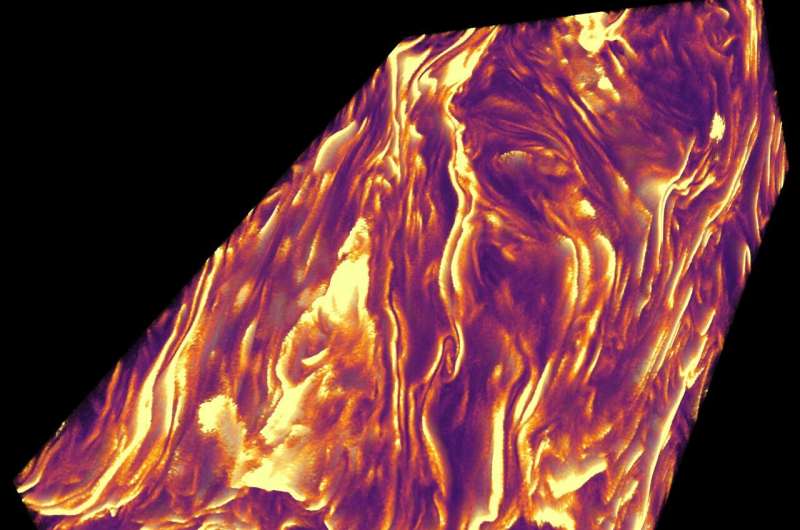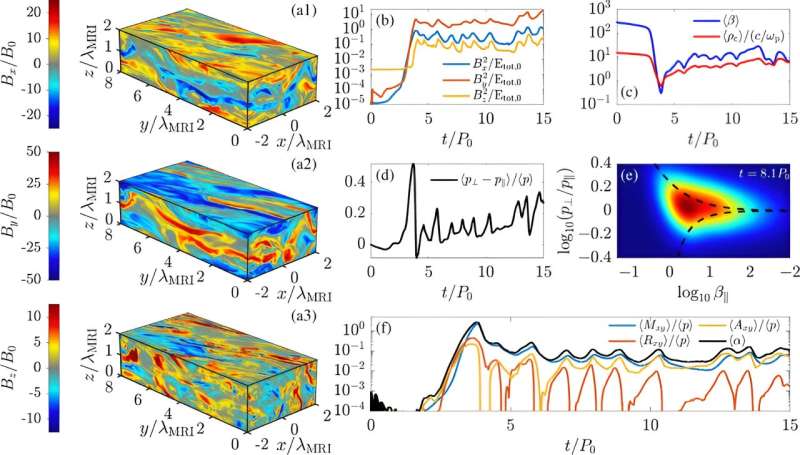August 14, 2024 feature
This article has been reviewed according to Science X's editorial process and policies. Editors have highlighted the following attributes while ensuring the content's credibility:
fact-checked
peer-reviewed publication
trusted source
proofread
A first definitive demonstration of nonthermal particle acceleration in magnetorotational turbulence

Researchers at KU Leuven, the University of Colorado, Boulder, the Flatiron Institute, and the University of Wisconsin–Madison recently set out to answer a long-standing research question, specifically whether charged particles in the turbulent flows commonly surrounding black holes and other compact objects can be accelerated to very high energies.
Their paper, published in Physical Review Letters, outlines the results of extensive simulations they ran, which demonstrate the nonthermal acceleration of particles in the kinetic magnetorotational turbulence naturally occurring in plasmas.
"An open question in the field of black-hole plasma astrophysics is: Can charged particles (e.g., electrons and ions) in turbulent flows around black holes be accelerated to very high energies?" Fabio Bacchini, lead author of the paper, told Phys.org. "This question has very profound implications for our understanding of the extreme environments found around black holes such as those recently observed, e.g., by the Event Horizon Telescope Collaboration."
To answer this key question about the acceleration of charged particles in turbulent flows, Bacchini and his colleagues first had to model the turbulence in the extreme environment around black holes. These unique environments are characterized by the so-called magnetorotational instability (MRI), a powerful magnetic-field amplification process that naturally occurs in plasmas that are subjected to shears and other forces found in the environment surrounding black holes.
"If you look at it as an isolated process, the MRI evolves through several stages and eventually reaches a 'turbulent saturated state' (i.e., a turbulent state where the MRI amplifies magnetic fields while also these fields are continuously destroyed via dissipation mechanisms)," Bacchini said.
"This state can be essentially maintained forever, and we think this is the state in which plasmas are commonly found around black holes. So, we cooked up a simulation where we model the MRI evolution up to the turbulent stage."
After they simulated the evolution of the MRI leading up to turbulence, Bacchini and his colleagues were ready to address their initial research question. As they simulated the MRI throughout its various stages, however, the charged particles in their simulations were already affected by the dynamics that occurred in the system before it reached turbulence.
"You can't really answer the question, because particles in the simulations 'remember' what happened before the turbulent state (including any acceleration they got), and their evolution through the subsequent turbulence is not agnostic of those pre-turbulence stages," Bacchini said.
"The main aim of this work was to study particle acceleration in the turbulence agnostically of initial conditions, to be able to answer the question above without 'pollution' from pre-turbulence stages that would not really be observed in nature in such an isolated way (but that necessarily occur in simulations)."
Essentially, the key objective of the recent work by Bacchini and his colleagues was to identify an efficient strategy to remove pre-turbulence effects, so that they could use their simulations to selectively measure the acceleration of particles in the turbulence phase.
They were ultimately able to devise a method (relying on physically motivated radiative dynamics) to suppress these pre-turbulence effects; yet, to answer their initial research question they also had to attain the largest possible physical system sizes.
"We had previously found that simulating the MRI in physical systems that are too small (and especially if not capturing three-dimensionality) produces very unrealistic results," Bacchini said.
"For example, if the system size is too small, the MRI does not even develop any turbulence. Hence, we needed extremely large, 3D simulation boxes, much larger than anything that was achieved before. This implied having a simulation code that could run such large simulations for a very long time, and then actually running the simulations on a suitable supercomputer."
Bacchini and his colleagues ran their computer code very efficiently on over 250,000 CPUs at the Argonne Leadership Computing Facility (ALCF) for several continuous weeks. This allowed them to simulate a system large enough to realistically reproduce MRI dynamics.
"The MRI was simulated previously via 'fluid' approaches," Bacchini said. "These theoretical models are insightful to capture large-scale plasma phenomena, but they contain no information on single particles (so they can't be used to answer the question above).
"For our purposes, we needed to simulate the MRI with a 'kinetic' approach, i.e., capturing single-particle dynamics. For realism, we also needed to evolve many particles (on the order of 50 billion) for a very long time."

The researchers were thus able to attain a first-principles description of the evolution of MRI. This description, which outlined both large-scale fluid behavior and particle-scale phenomena, ultimately helped them to answer their research question.
Bacchini and his colleagues were able to directly demonstrate that particles can in fact be accelerated within MRI-driven plasma turbulence, agnostically of initial simulation conditions. In their simulations, they observed particles starting at relatively low energies, comparable to those associated with plasma commonly found on Earth, but then reaching exceedingly high energies at which relativistic effects come into play.
"Basically, these particles achieve speeds very close to the speed of light," Bacchini said. "The energy needed for this acceleration comes from magnetic fields, that dissipate their energy reservoir via the turbulent cascade we model.
"It is commonly believed that massive amounts of energy are stored in large-scale magnetic fields around black holes. These magnetic fields can be created and amplified via processes like the MRI, feeding on the black hole gravitational energy.
"Our work essentially shows that this magnetic and gravitational energy can be tapped into, resulting in highly energetic particles accelerated via MRI-driven turbulence."
At the remarkably high energies simulated by Bacchini and his colleagues, particles can start to emit radiation (i.e., photons), which could be observed using specific instruments. Some physicists have suggested that this was the type of emission picked up by the Event Horizon Telescope around some supermassive black holes, including M87*.
"We ran the largest MRI simulations with kinetic descriptions to date, which also show how the kinetic dynamics reproduces the fluid one at large-enough scales," Bacchini said. "We ran diagnostics in this direction, observing for example that particle acceleration along or transversely with respect to the local magnetic-field direction contributes strongly to redistributing angular momentum throughout the turbulent plasma.
"This helps us understand how 'accretion flows' (i.e., plasma flows spiraling around and slowly falling into black holes) can exist, since the accretion itself implies the existence of angular-momentum-redistributing mechanisms."
While large telescopes on Earth have detected radiation around black holes in recent years, its origin remains poorly understood. The simulations run by this team of researchers could contribute to the understanding of how this radiation in the immediate vicinity of black holes is produced.
"Understanding this emission is extremely important because radiation (light) carries information about these extreme environments, and it's one of the few sources of information we have about them. (We can't really send probes to black holes, since there are no black holes close to Earth...)," Bacchini explained.
"Even more importantly, by understanding the plasma dynamics and the subsequent radiation close to a black hole, we can obtain information on the black hole itself, on its mass, on its spin, etc., which all influence the plasma dynamics and which we account for in simulations."
By potentially enriching the understanding of plasma dynamics and radiation in the vicinity of black holes, the methodology employed by Bacchini and his colleagues could allow physicists to indirectly test Einstein's theory of general relativity. Before this can be achieved, however, the team will need to run various other simulations.
"These runs employed a number of simplifications to make them feasible," Bacchini said. "Most notably, we assumed the plasma composition to be made of pairs (electrons and positrons, which have the same mass) for simplicity. This allows us to still retrieve the correct global dynamics and probe particle acceleration to some degree, but in realistic systems one must consider the presence of electrons and of (much) more massive protons instead.
"This increases the computational effort required by orders of magnitude, because particles of different mass cause kinetic phenomena at different spatiotemporal scales, and you have to capture all those scales in a simulation."
Bacchini's group at KU Leuven is currently working on additional and larger simulation runs that also include electrons and protons. They hope that these simulations will soon allow them to address their initial research question related to the acceleration of particles in near-black hole turbulence with even greater accuracy.
"Other possible directions for future research are the direct inclusion of radiative processes (which can modify the plasma dynamics itself) in our simulations, and the inclusion of stratification (essentially considering that plasma changes density away from the black hole's equatorial plane)," Bacchini added.
"The latter in particular was explored for the first time in a recent work led by collaborators in Chile, and plenty more remains to do still."
More information: Fabio Bacchini et al, Collisionless Magnetorotational Turbulence in Pair Plasmas: Steady-State Dynamics, Particle Acceleration, and Radiative Cooling, Physical Review Letters (2024). DOI: 10.1103/PhysRevLett.133.045202. On arXiv: DOI: 10.48550/arxiv.2401.01399
Journal information: Physical Review Letters , arXiv
© 2024 Science X Network





















